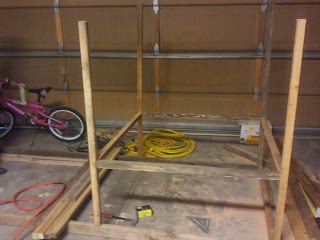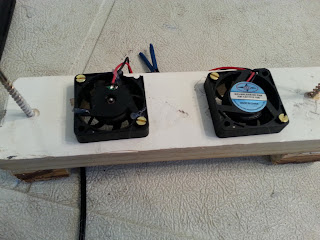Earlier this year we ordered 18 day old polish chicks from a hatchery. We lost nearly half of them within the first few days! Even with the replacements we lost a lot. What a lesson in the circle of life for DD! The plus side is she is much better about handling death. We are still looking to add 3 bantam (the smaller size) chickens to our flock but shipping chicks was not only expensive, it seemed too stressful on the little things. Yes, I could've kept buying from local farm stores but the selection is limited. So I decided to hatch my own. Unfortunately I'm very frugal so I couldn't bring myself to spend hundreds of dollars on an incubator. Thanks to www.backyardchickens.com I decided to make my own out of an old cooler we had in the garage.
Parts needed:
cooler - $0
thermostat - $27. I went with a wafer thermostat after reading about it.
heating element - $0
thermometer/hygrometer - $5
turner (pvc pipes) - $4 in connectors
fan(s) - $2
glass - $2 (would've been $1 if I hadn't broken the first piece)
Total - $40!
For the fan I ordered 2 PC fans off ebay for .97 each. When they arrived I was surprised to find that they were little chip cooler fans, not the tower fans. So instead of the 3x3 fan I was expecting they were 1x1. So instead, I took one out of an old computer we have laying around collecting dust. I cut the connector off the end and wired it to an old 12v plug. Plugged it in and it was a virtual wind storm! My friend could feel the flow all the way across the room. Obviously that would not work for our poor little eggs! It is not being used to keep our electronics cool in our tv cabinet. :)
So I went back to the two little ones, maybe they would work after all! Wolf had the great idea to mount them on a piece of wood with holes drilled in it. So that's what I did.
Here is the wood base.
And the fans. I wired the fans to an old 12v cord we had laying around. I knew I kept all those cords for a reason!
Mounted on the board. Of course as I went to screw one on the drill slipped and I busted the fan. Nothing a little hot glue couldn't fix though (not fixed in pic).
Used some long screws to mount it on the side of the cooler. Note, this was a test run. I later used wire nuts instead of tape and moved the wires out the hole that was drilled for the turner.

Next I tackled the heat source. I already had some light bulb bases from a science kit my mom gave me a few years ago. This is what they looked like. Rather than the bases most instructions show mine had plugs on the end rather than just the wires. I opted to use two bulbs in case one burns out I won't lose all the eggs.

I unscrewed the top part and pulled off the protective red plastic to expose the wires. I needed to do this not only because that's where the screw holes are but because I needed to know which wire went with which color screw so I could wire the two lamps together. I also wanted the wires to come up through the base so it would sit flush on the cooler wall. You can see my hole in the cooler behind this. I drilled these before really looking at my hardware. I was first thinking I could put this base on the outside of the cooler, stick the metal part through the hole, and screw on the top part to hold it in place so I drilled a hole large enough for the metal piece. Had I taken the thing apart first I would've seen that the metal piece was nowhere near long enough to stick through the side of the cooler, and the wires were detachable so I didn't need a large hole. But oh-well, it didn't hurt anything in the end.

I cut off the wire connectors, pulled the wire up through the holes in the base and reattached. Then screwed the whole thing onto the cooler wall, reinstalled the plastic cover and the top ceramic piece.
My thermostat hadn't arrived at this point so the wires just hung for a few days. But here is a pic of the trial wiring after installing the thermostat. I later replaced all tape with wire nuts. It's hard to tell but I cut the plugs off the lamps and wired the thermostat in to the circuit and wired both lights onto one plug. The wires coming out of the middle are from the theromstat, the metal thing sticking out the middle is the temp controller for the thermostat.

Next step was a turner. I didn't want to have to open the incubator to turn a bunch of eggs by hand. That seemed like it would lower the temp too low for too long. So after looking at a few pics I created a pvc turner. The pvc was the extra cuttings from our row covers in the garden. I just had to buy the connector pieces. The end under the fans sticks out about 4 inches and has a T piece as a handle. This allows turning the eggs from outside the incubator to the perfect angle. I decided how high to put the holes for the turner by holding it at the max angle I wanted and made sure it wouldn't come too close to the light bulbs. The pan underneath is a foil pan that will hold water to add humidity.

Next I needed a window for viewing without lifting the lid. I went to the dollar store and bought an 8x10 wooden frame (another great Wolf idea). I traced the glass, drilled pilot holes in the corner, and then cut out the middle with a jig saw. Next I screwed the frame and glass down onto the lid, drilling pilot holes in the frame/cooler first. This gave a nice window with no chance of cutting myself and no need for duct tape like others used. If you were paying attention at my costs, you see I had to buy a second frame. Well, the take away lesson from that is use a hand screwdriver when screwing in the frame. The only thing I could figure out is that the screw hit the glass and snapped it. The second one went on fine.
Here is the finished product.
A close up of the inside. You can see my wafer thermostat in the middle there and the digital thermometer/hygrometer. To adjust the temp you turn the key on the back of the cooler. I also put a calibrated thermometer from work in there to see how far off the temp was, turns out it wasn't! I got the temp set to 99.5-100. My thermometer also records the high and low temp for a period (until you hit reset) so I did that over a few hour span and the temp only moved 1 deg. That should be steady enough.
Now to get some eggs!


































.jpg)



.jpg)









